I'm thinking 4 Batteries may be better than 6. Efficiency improves when Vin is close to Vout. The minimum for the driver is 4.5 V. A fully charged cell will put out between 1.25 and 1.4V. You do not want to discharge them down to under 1.2V to avoid deep discharge which will significantly reduce lifespan. By reducing the number of cells you may also avoid deep discharge when the voltage drops below 4.5 and the chip shuts down. Better efficiency, better battery life, and less batterie$. Not a bad deal
Running the Emitters in series you will raise the forward voltage closer to Vin improving efficiency, you will eliminate two inefficient sources of waste. Greatly improve efficiency, reduces watts by 1 Watt, improve battery life significantly, lower the cost and reduce the PCB real estate.
You efficiency calculations do not seem correct. 930mA @ 1.54 volts = 1.43 times 3 circuits = 4.29 Watts. And that is just from the IR emitters. So add the expected 20% inefficiency absorbed by the driver and you are at 5.1 Watts. That is twice your input Wattage.
For more than you ever wanted to know about batteries check out Battery University BU-215 should be useful to you.
In light of the IR revelation, A lower input voltage would help if you can't run them in series. You are at 6:1 in/out ratio. You do need a good output cap. From pg 8 of datasheet: as the ESR of this capacitor appears in series with the supply source impedance and lowers overall efficiency... A minimum value of 10μF is acceptable if the input source is close to the device. Your input is 6x output.
Why do you use 3 separate drivers and drive them all with the same intensity? It would be much more practical all around to put them in series.
The datasheet recommends a minimum of 33uH. You may be better off with 47uH.
Are you sure about the 1.54V forward voltage? That sounds very low even for an amber or red LED unless being driven low by excessive heat. What is the temperature? Any other color than red, red-orange, or amber I would not believe that voltage.
If real what's the part number?
Their reference design uses a Wurth 744770133 33μH,3.2A, 64 mOhm Max, Qty 1 Digikey: $4.53.

Your max efficiency @980mA is specified at about 85%, 97% is for 2 LEDs @ 1Amp, using a 47uH inductor.

This looks to be the least expensive 33uH(with a better resistance than Wurth) that Digikey has for a 33uH:Taiyo Yuden NS12555T330MN 33µH, 3.16A, 49.8 mOhm Max, Qty 1 Digikey: $1.96
UPDATE
I was looking at the specs on the "LED" you are using. It makes zero sense. Specifically: MCD=70@750mA, MCD=75@1000mA
There is something wrong with this supplier. They know not what they sell.

MilliCandela is a luminous measurement. Luminous only applies to human visible light. Plus it should state the steradians (sr) at that Intensity or Irradiance (their spec does not differentiate between the two). The proper measurement is is mWatt/sr (Radiant Intensity) or µMoles/sr (photon, quantum).
A page from my paper "Understanding LEDs"

They do not mention the manufacturer, probably someone on or buying off Alibaba. ColdfusionX is an eBay Store.
I would take a serious look at OSRAM IR Emitters,aka LED, (even as much as I hate Siemens). Check out SFH 4714 and SFH 4715
RE: 3 LED String vs. 3 Drivers:
"They" need extraordinary justification. I cannot image ANY reason for doing so if the current through each LED will always be the same. Failure rate is very low if the temperature is kept reasonable. If reliability is an issue, then lower the current and increase the number of Emitters.
I would never power LEDs in parallel without a series resistor in each branch to balance the currents between the branches, especially if the LEDs are intended to be powered close to their maximum current. If you don’t try the balance the currents, a branch may get slightly more current than the others, which will make the LEDs in the branch slightly hotter, changing the U-I characteristics such that the branch will get more current, and you have thermal runaway. I think a 1Ω resistor in each branch should be enough.
The pulse current is the maximum current allowed in the LED for a short time (for example if one wants to flash the led for a still picture camera). The max current should be the maximum current the LED can accept, probably with perfect thermal dissipation. I’d rather not use currents much higher than the nominal current.
Your calculations for resistor values and power dissipations look fine to me.
Edit: it is not fine. First, if the maximum current in your LEDs is \$4 \times 90\textrm{mA} = 360\textrm{mA}\$ you should certainly not design a current regulator for a higher current, or you will burn your LEDs. You should rather design it for a lower current to ensure you won’t burn them. I’d go for \$4 \times 60\textrm{mA} = 240\textrm{mA}\$. Then, you’d get \$\textrm{R5} \parallel \textrm{R6} = \frac{0.7\textrm{V}}{0.24\textrm{A}} = 2.9\Omega\$, with \$\textrm{R5} \parallel \textrm{R6} = \frac{\textrm{R5} \times \textrm{R6}}{\textrm{R5} + \textrm{R6}}\$. If you choose \$\textrm{R5} = \textrm{R6}\$ (which is sane), you have \$\textrm{R5} \parallel \textrm{R6} = \frac{\textrm{R5}}{2} = \frac{\textrm{R6}}{2}\$, hence \$\textrm{R5} = \textrm{R6} = 5.8\Omega\$.
Your circuit is more a current limiter than a current regulator. It works because when current gets (too) high, the Vbe of T1 gets high, and then T1 will reduce the Vgs voltage of Q1, which become more resistive and will reduce the current. R7 is useful so that T1 can reduce the voltage. Without it, you might just burn T1 if WHITE_GPIO was connected to a low-impedence voltage source.
I have no idea about the use of R21.




Best Answer
Your maths is not quite correct. You are right that the LED will be drawing 4.9W, and most of this will be converted to heat (about 80%). You are also correct that the current draw from the battery to power the light will be 1.6A. However, you do not multiply the voltage difference to get the heat dissipated by the IC. This is a switching converter, so the heat dissipation to the chip is a function of the efficiency of the chip, which depends on the mosfet resistance, switching speed, and other things (plus the inductor ESR). Usually the datasheet will give you an idea of the efficiency at different currents and voltages. Looking at the graphs, its probably around 80%, so your heat in the chip will be about 1.2W, and your total current draw from the battery will be 2A.
You are also correct though that this chip will not be able to drive 700mA, since you need 2A inductor currents.